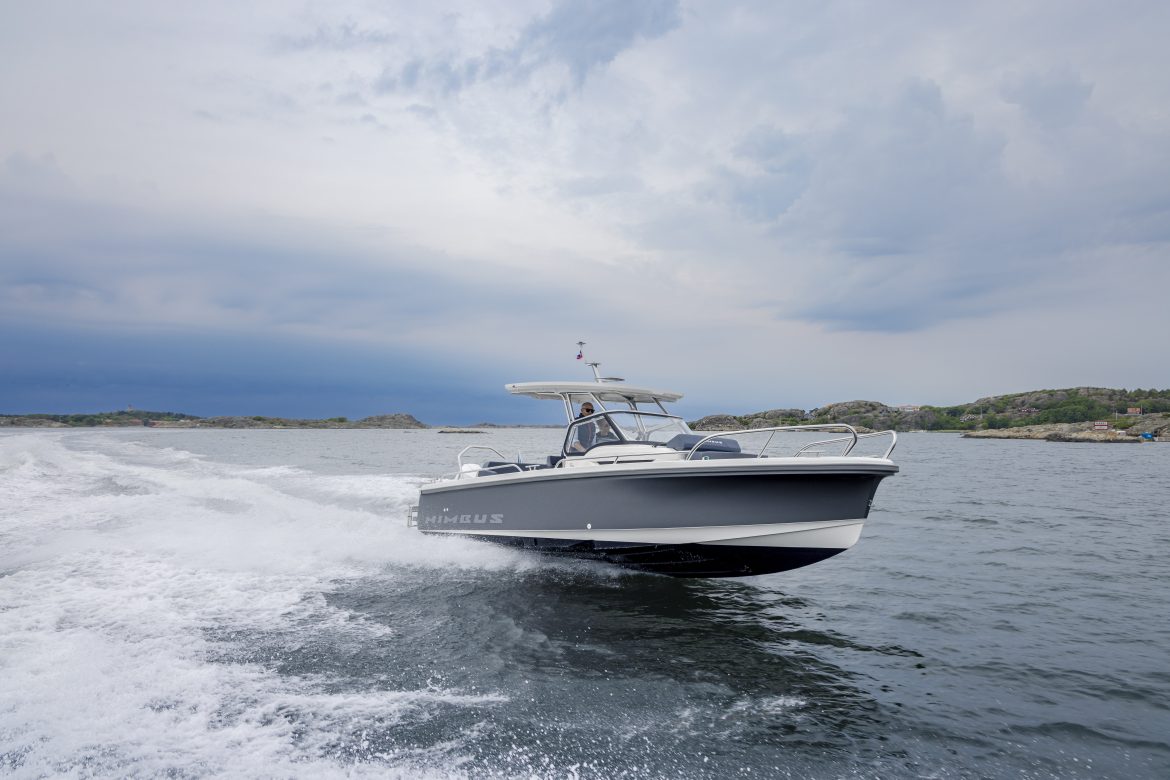The T8 is the smallest of three Tender models from Nimbus, but these boats have lots of funky ways to make one piece of equipment transform into something else – so you get a lot of activities in one boat.
As superyachts have got bigger and increasingly sophisticated, so have their tenders. As well as providing a passenger service, they exploit their small-boat advantage of being ideal for picnicking, exploring bays, diving, swimming and watching yacht races. All of which suits family boating: not too big, not too small, but safe, comfortable and with plenty of ways to enjoy the water. And so it is with the Tender series of Scandinavian builder Nimbus, whose megayacht tenders proved ideal as family dayboats.
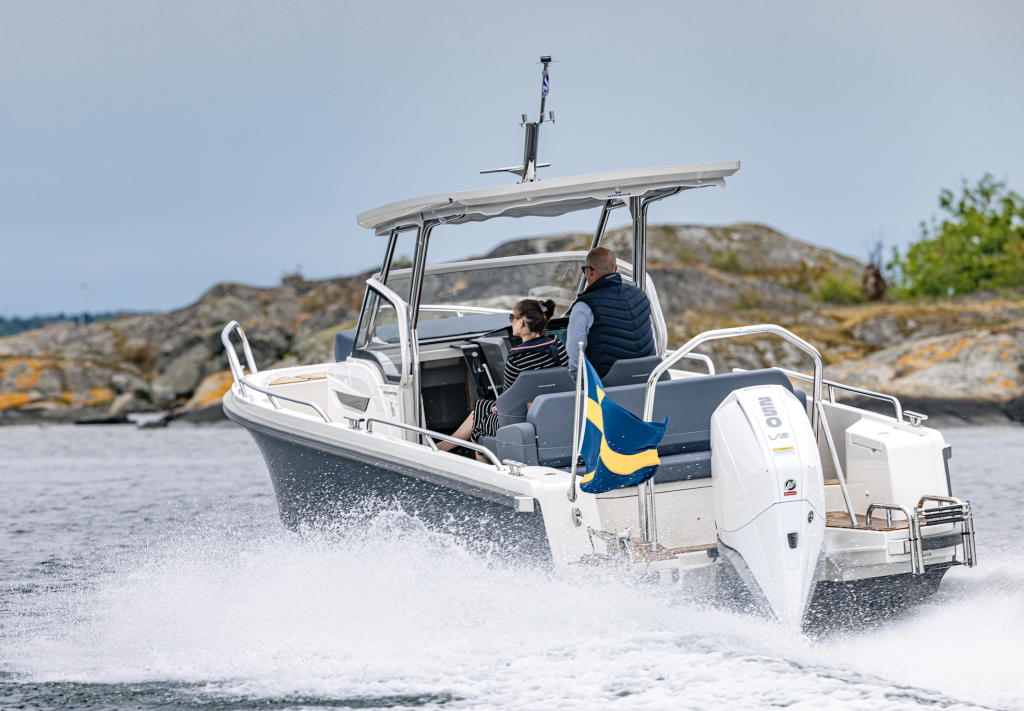
PERFORMANCE
The T8 was designed as a tender and evolved to become a family cruiser, so it’s most comfortable at cruising speeds. With the single 300hp Mercury turning a 19-pitch Rev 4 prop, its sweetest cruise speed is 26.1 knots at 4000rpm. At around 26 knots, she goes right through the waves and has time to penetrate those waves. The 37.6 lph fuel burn offered a range of 149.8 nautical miles, while still holding a 10% reserve of the boat’s total 240 L fuel capacity. Apply the power, and her speed topped out at 46 knots at 5980rpm, but then she’s opposing the waves and hitting hard. Slow things down, take it easy, keep it at cruise speed and everybody will be comfortable on board. With 4 1⁄2 turns from lock to lock, she’s responsive to the helm. The T8 features the air-lubricated stepped hull which, Nimbus believes, provides excellent seafaring qualities and a low planing threshold.
COCKPIT CENTRAL
The cockpit is the central gathering area on the T8, specifically for its 152.4cm wide, forward-facing bench seat, like the back seat of a family car. It’s just aft of a collapsible table mounted behind the helm and observer’s seats. But, like a seat on a commuter train, the back of the forward-facing seat flips forward to create an aft-facing lounge. Drop the seatback all the way, and you’ve just created a large sunbed. The aft section lifts to reveal a storage bag snapped into place around the perimeter; unsnapped, it reveals the mechanical components such as bilge pumps and steering pump. In another configuration to this area, the table, in solid teak with a satin finish and beverage holders, flips up into the usable position. The helm and observer seats flip their backs to face the bench seat with the table in between. This cosy al fresco setting for four can be enclosed in Isinglass for three-season comfort. Throughout, good, practical thinking abounds. Beneath the bench cushion is a fully gasketed hatch supported with a gas strut, which lifts to reveal a storage locker. A channel directs water away from the interior to keep it dry. The under-seat storage is home to an electrical panel that includes the battery switches, crossover switches, main breakers, gauges for the water tank and the 41.64L diesel tank that powers the Webasto cabin heater and the hot water heater. Even with the larger footprint of the sunbed configuration, there’s still full walkaround capability on three sides. We measured 30.5cm between the seat and the bulwarks that come up to 271cm with rails that top out at 78.74cm.
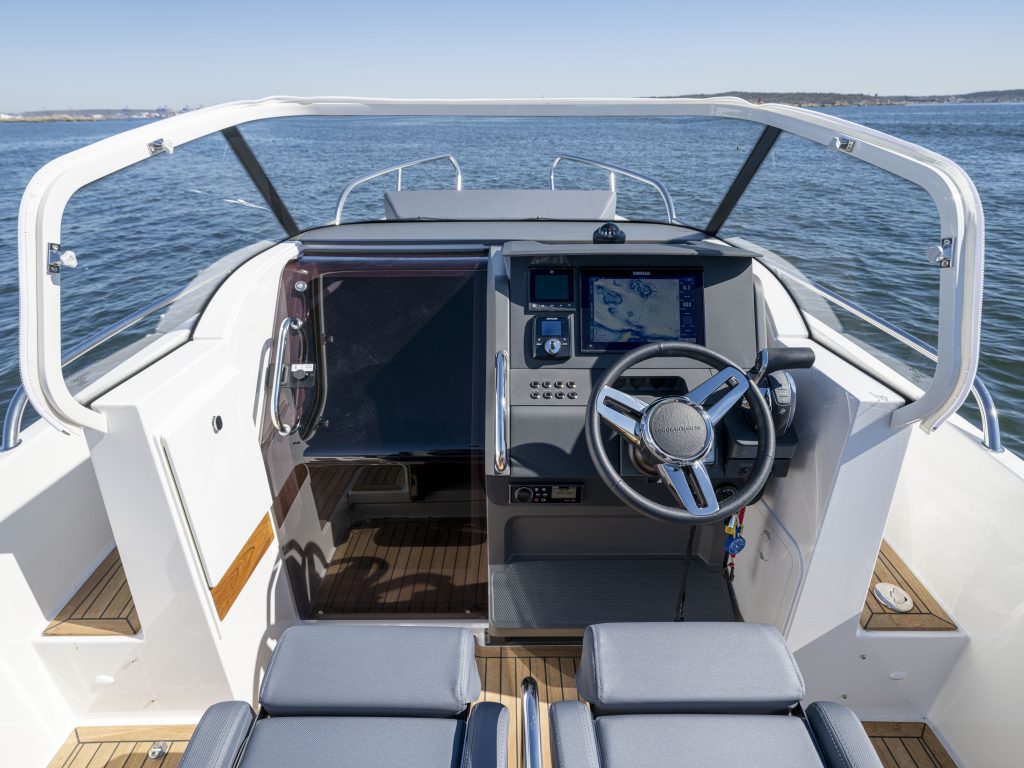
STERN TREATMENT
The power options are a 200, 250 or 300hp outboard for which there is full walkaround capability, which is good for maintenance and easy access between the seating area and the stern. A tow sport bar over the outboard engine provides a convenient grab handle when transitioning across the stern or when using the three-step boarding ladder to the starboard platform. The port side has a feature which is rare Downunder: a stern anchor and its windlass. In Scandanavia, boats are routinely anchored at the stern while passengers step ashore from the bow. That’s a less common scenario in New Zealand and Australia, but it’s likely the stern anchor will prove useful in other ways: for example, keeping the bow into the waves at anchor or when securing it off a beach. There are swim platforms on both sides; a hatch in the portside step conceals a propane tank for the optional gas grill that mounts beside the helm. Also to port is the shore power. Modules either side hold lines and fenders.
SHELTER AND SHADE
In the standard configuration, the helm and seating have no overhead protection. The options are a T-Top with a polycarbonate roof and canopy or, as on our test boat, a fibreglass hardtop with smoked plexi skylights. It’s 1.96m off the deck and even though it is angled down at the forward end, a step down at the helm brings it to 1.98m. Heavy-duty supports serve as grabrails to the sides and a track holds a zipper to allow the main deck area to be enclosed. Brackets in the deck secure the bottom of the enclosure. A rail to the trailing edge can accommodate optional rocket launcher style rod holders. Other features in this hardtop include rails, courtesy lights, enclosure support and skylights. There are even racks at the hardtop to support stand-up paddleboards and a spreader light at the front.
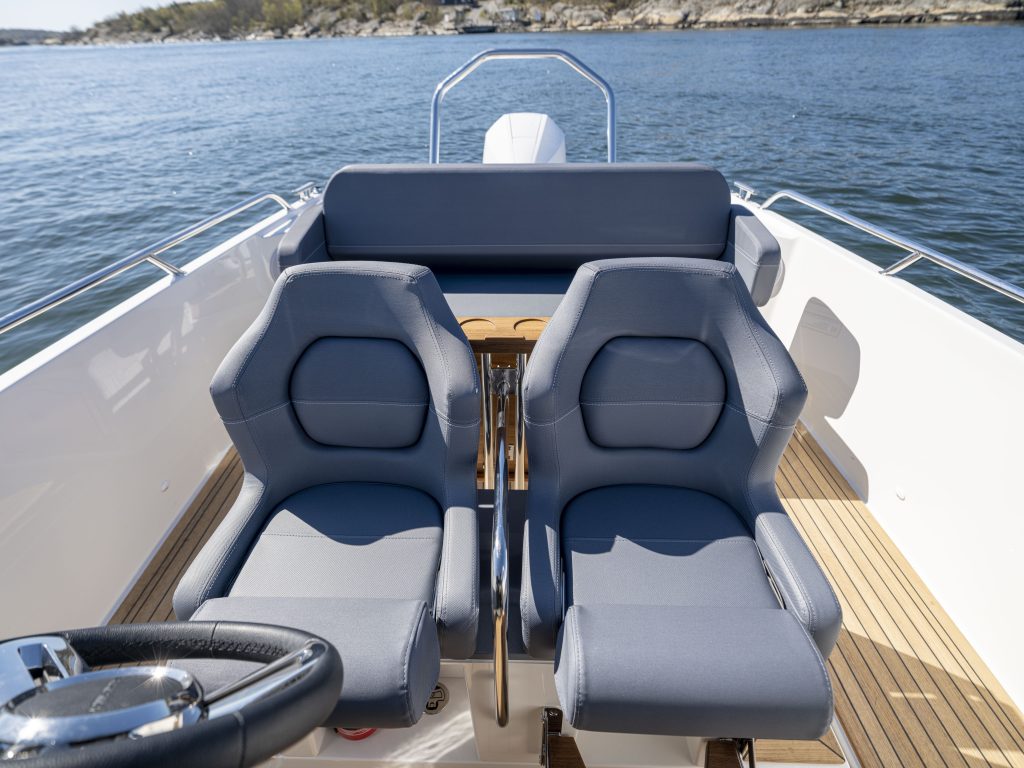
SIDE DECKS
The symmetrical layout provides 30.5cm wide side decks to port and starboard. Bulwarks at the cabin sides are 38cm high and rails top out at 50cm. Decking is standard moulded non-skid but owners can choose from teak decking or Eco-Teak. There are three cleats on each side and a bracket to secure a canvas enclosure.
RELAXING ON THE BOW
The bow is always a favourite spot for someone and they will enjoy the lounge seat/sunbed that extends 61cm from a backrest and to 137cm with a filler cushion. Beneath the main cushion is a hatch above the berth below; this is handy when loading items into the cabin. The foredeck is on a raised platform with Flexiteek providing non-skid access off the bow through the spilt rails. A hatch at the bow protects an electric windlass, optional, which services the anchor on its dedicated roller. Brackets at the caprails support an optional beach boarding ladder.
AT THE HELM
The helm is starboard-mounted, with a panel suitable for a generous display up to 30.48cm. The Zipwake tab control is to the left of the screen. Electrical switches are below and to the left, and a small cubby ahead of the wheel includes connectivity. A remote beside the console controls the bow thruster, standard on all Nimbus boats, and fore and aft windlasses. A smoked plexi door at the helm down to the two-person, 193cm berth beneath the foredeck. There’s space for an optional sink to port, just across from the head compartment.
OBSERVATIONS
The Nimbus T8 delivers Scandinavian styling and sensibility with a range of options, well-crafted in a small space. She won’t win speed records but she’s highly functional, easy to handle with bow thruster, fore and aft windlass anchoring and three cleats a side. She keeps her crew safe and comfortable, while providing for many on-water activities – a suite of qualities that have made her ideal as a megayacht tender and a family fun boat.
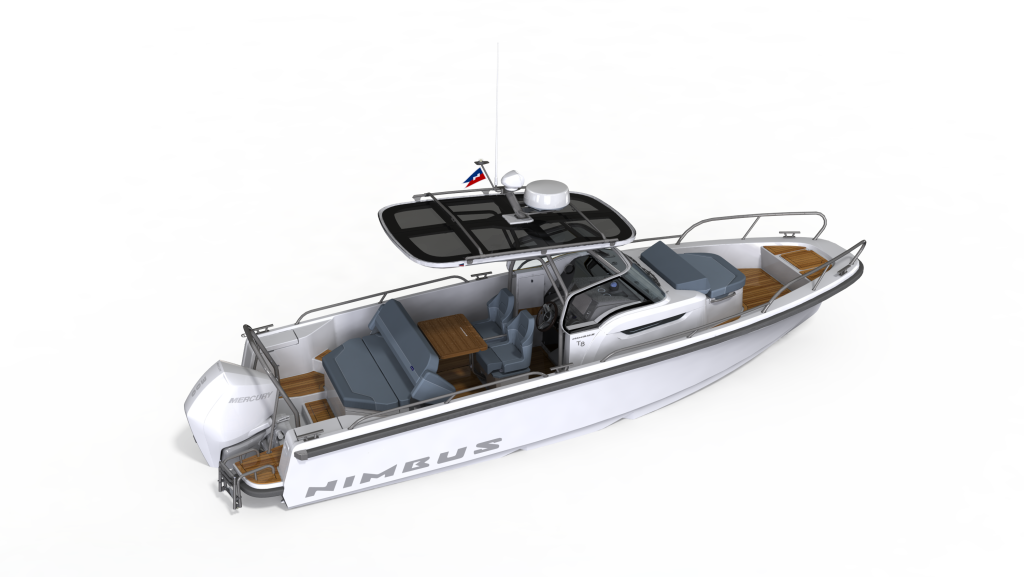
SPECIFICATIONS
- Model Nimbus T8
- Priced from NZ $ 276,000
- Length Overall 7.93 M
- Beam 2.54 M
- Dry Weight 2,300 Kg
- Draft 0.96 M
- Fuel Capacity 240 L
- Water Capacity 50 L
- Engine Options STD. POWER 1 x 200-hp Mercury Verado V6, OPT. POWER 1 x 250-hp Mercury Verado V8, 1 x 300-hp Mercury Verado V8


